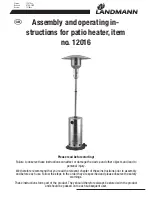
12
Venting System Condensation
Condensate formation does not occur in all installations of power vented water
heaters but should be protected against on installations where condensation
can form in the venting system.
Formation of condensation in the venting system of power vented water heaters
is dependent upon installation conditions including, but not limited to:
ambient temperature and humidity of installation location;
ambient temperature and humidity of venting space;
vent distance and slope;
and product usage.
In order to effectively control condensate from adversely affecting the
mechanical components of the water heater several methods may be
employed:
1. For horizontal installations the vent pipe can be installed with a
downward slope (not less than 1/8"
(3 cm)
) and away from the blower.
2.
In order to prevent condensate from draining back into the blower
(vertical or horizontal runs), an optional condensate kit is available as a
service part (Condensate kit, p/n 239-45875-00). A molded exhaust
adapter with drain outlet is secured with one hose clamp, to the vent
pipe. Tubing is provided to drain any accumulated condensate away
from the water heater and to a suitable drain. The kit comes complete
with instructions for proper installation.
Venting Specifications for 40 Gallon
(151.4 L)/
50 Gallon
(189.2 L)/
60 Gallon (227.0 L):
This water heater is a power vented appliance and is designed to vent its
products of combustion through 2 in
(5.1 cm)
or 3 in
(7.6 cm)
diameter vent
pipe to the outdoors. The water heater may be either vented horizontally
through the wall or vertically through the roof. Use a 3 in
(7.6 cm)
to 2 in
(5.1
cm)
reducer to connect to the vent outlet when using 3 in
(7.6 cm)
vent pipe.
Apply proper cement at joint locations. Table 1 lists the maximum vent lengths
for this water heater using 2 in
(5.1 cm)
vent pipe. If possible, locate the water
heater so that the venting length and number of elbows are kept to the
minimum distance necessary to reach the outside. If the installation requires
venting lengths that exceed the lengths listed for 2 in
(5.1 cm)
vent pipe in
Table 1 then use 3 in
(7.6 cm)
vent pipe for the vent connector.
Table 2 lists the venting distances allowed with 3 in
(7.6 cm)
diameter vent
pipe.
When venting with 3 in
(7.6 cm)
vent pipe
, use a 3 in
(7.6 cm)
to 2 in
(5.1 cm)
reducer to exit through the building wall with 2 in
(5.1 cm)
vent pipe.
Use the 2 in
(5.1 cm)
vent terminal supplied with the water heater to terminate
on the outside of the building. If the length of the 2 in
(5.1 cm)
needed to go
through the wall is greater than 14 in
(35.6 cm)
, use 3 in
(7.6 cm)
vent pipe to
go through the wall and reduce to 2 in
(5.1 cm)
vent pipe immediately after
exiting the outside wall. Refer to the venting illustrations on the following pages.
If replacing a water heater and the existing vent terminal is identical to the vent
terminal supplied with the new water heater, replacement of the vent terminal is
not required. The vent terminal should be inspected to make sure that it is in
good condition.
Summary of Contents for RG1PV50S6X19-264
Page 25: ...25 Wiring Diagram Figure 6...
Page 27: ...27 Lighting Shutdown Instructions...
Page 39: ...39 NOTES...
Page 40: ...40 NOTES...













































